 |
| Category: Assorted/Heroes |

|
|
|
|
|
|
First Aboriginal Commissioned Officer
– Reginald Saunders MBE |
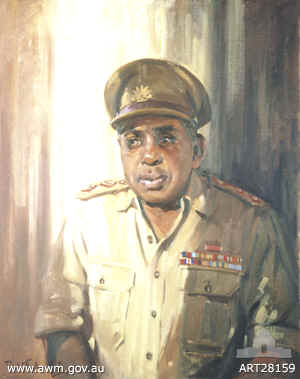 |
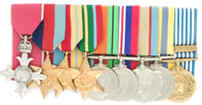
Reg Saunders’s medals.
AWM REL/18641
-
Served
in North Africa at Benghazi.
-
Served
in Greece.
-
12
months behind the lines on Crete.
-
Served
on the Kokoda Track and lost a brother there. Promoted Lieutenant
(Platoon Commander)
-
Served
as a Company Commander at Kapyong and fought at Hill 317.
|
- Member of the Most Excellent Order
of the British Empire (MBE)
- 1939/45 Star
- Africa Star
- Pacific Star
|
- Defence Medal
- 1939/45 War Medal
- Australia Service Medal 1939/45
- Korea Medal
- UN Medal for Korea
|
| Many thousands of
Australian Aboriginals have enlisted and served in Australia’s defence
forces since 1901, and several have won decorations, but the first to be
promoted to a commissioned rank was Reg Saunders of Victoria.
Reginald Walter Saunders was born a
member of the Gunditjmara people, just outside Framlingham Aboriginal
Reserve in the western district of Victoria on 7 August 1920.
His father, Chris Saunders, and uncle,
William Reginald Rawlings, had served with the first AIF. Reg was named
after his uncle, who served in the 29th Battalion and was awarded a
Military Medal for “displaying rare bravery in the performance of his
duty … his irresistible dash and courage set a wonderful example to
the remainder of the team”. Reg grew to admire the military feats of
both his father and uncle. |
| Men of the 2/7th Infantry Battalion,
including Sgt Reg Saunders, waiting at their troop train in Queensland,
1943. AWM 057894
>>>
Reg’s mother died in 1924, and
shortly after her death he was taken by his father, along with his
brother Harry, to the Lake Condah Mission, where he received his primary
education. Reg did not like being away from his family and left school
at the age of 14 to go to work as a mill hand in a timber yard. |
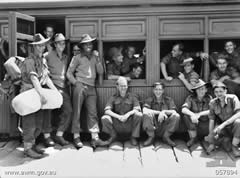 |
| As his father and his
mates talked about the First World War, Reg listened with “ears as big
as footballs, taking it all in”. Listening to all this talk made Reg
want to do the same. When he was given the opportunity to enlist in the
Second World War, Reg and his mates “went in swarms” to join up.
Reg enlisted in the second AIF (2/7th
Battalion of the 6th Australian Division) in April 1940. His outstanding
leadership skills, personable character and sporting skills were quickly
recognized by his superiors, as he was promoted to the rank of lance
corporal within six weeks. Three months later, he was promoted to
sergeant.
The first fighting Reg saw was in
Libya, where he joined the battalion as a reinforcement; he took part in
the continuing push to Benghazi, where he says he nearly died of fright.
Then on 9 April 1941 Reg accompanied his battalion to Greece, where,
under constant air attack, he took part in the fighting. The troops soon
withdrew and made their way to Crete. On this trip, the ship on which he
was travelling, the Costa Rica, was bombed and sunk. Reg managed to
scramble aboard a destroyer.
Reg’s brother Harry was now nearing
his 18th birthday; in a hurry to enlist, he convinced the recruiting
officer that he was old enough, and joined the 2/14th Battalion. Reg and
Harry met up while they were camped near each other in Palestine and
took leave together in Jerusalem.
In Crete, Reg again took part in
fighting against air attack. This was another ill-fated campaign, which
saw the British evacuated from the island. Reg was one of several
hundred troops left behind. After almost a full year of hiding out –
an easy task for Reg, who had dark skin and could easily pass of being
of Mediterranean descent – they were secretly taken off the island by
a British submarine in 1941.
Soon after returning to Australia, in
August 1942, Reg was posted back to the 2/7th battalion and sent to New
Guinea, where he proceeded to the Owen Stanley Range. "I preferred
fighting in the jungle. You had more cover in the jungle. And, being a
bush boy, I was at home in the jungle, because every time you ducked
down you were under cover. In the desert, if you ducked down they’d
just bounce bullets off you".
It was while Reg was serving in New
Guinea that Harry was killed in action on the Kokoda Trail. It was also
while he was in New Guinea that he was nominated for promotion to a
commissioned rank – the first Aboriginal Australian to have reached
this level of command in the Australian Army.
Reg was selected to return to Victoria
and attend Officer Training School, at the Infantry Wing of the Officer
Cadet Training Unit, Seymour. He graduated as a lieutenant in December,
1944. |
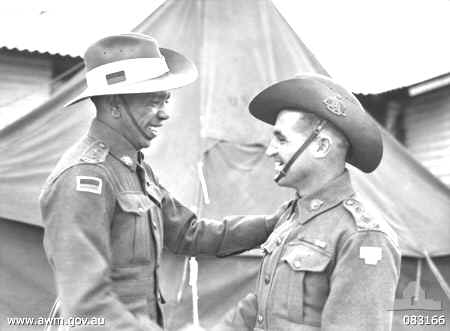 |
Lt R. W. Saunders and Lt T. C. Derrick
congratulate each other following their graduation from officer training
school, Seymour, Victoria, November 1944.
AWM 083166 |
On behalf of the
Aborigines’ Friends Association Adelaide, its secretary, Rev. Gordon
Rowe, wrote him a letter of congratulations, to which he replied on 18
December 1944:
Dear Sir,
Thank you very much for your kind
wishes and congratulations.
My philosophy is that once a person
undertakes to do something, no matter how big or how small, that
person should do it to the best of his or her ability. Which may
account for my very small part in helping pave the road to ultimate
victory.
Many thanks for your book. Many of
the people mentioned in it are very familiar to me.
You mentioned in your letter an
attitude towards people of my race. I am sorry, but neither you nor I
can change that attitude, because (the) changing of it rests with the
Aborigines themselves, and my contribution towards helping them is
just simply by setting myself up as an example – not by words, which
are cheap, but by deeds.
Once again, Sir, I thank you, and
wish you and your fellow workers all the best of luck.
I remain,
Yours sincerely,
(Sgd.) R. W. Saunders
Reg spent the remainder of the war as
a lieutenant in charge of a platoon of up to thirty Australians.
Reg later served in the Korean War,
where he was promoted to captain in charge of “C” Company of the 3rd
Battalion, and took part in the famous battle of Kapyong in 1951. It was
during this battle that the battalion was awarded a US Presidential Unit
Citation.
North Korea, November 1950. Reg
Saunders and other soldiers from his unit, including a Korean
interpreter, are gathered around a small campfire on which a billy
is boiling.
P01813.866 |
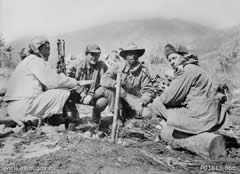 |
After having fought the battle for
Hill 317, Reg finally left Korea in October 1952, and resigned from the
regular army in 1954. He moved to Sydney after the war and soon became
the captain of his local cricket team and president of a sub-branch of
the RSL.
In 1969, Reg moved to Canberra and
took up employment as liaison officer at the Department of Aboriginal
Affairs, remaining there until his retirement in 1981.
He was awarded an MBE in 1971, and was
appointed to the Council of the Australian War Memorial in July 1985.
Reg died on Friday 2 March 1991, aged 69.
A scholarship, established in Reg’s
honour by the RSL, was launched in 1992 for drug and alcohol abuse
studies, and is aimed at students of Aboriginal and Torres Strait
Islander background. His medals and portrait are on display in the
Korean War gallery of the Australian War Memorial.
Garth O’Connell
Assistant Curator
Military Technology Australian War Memorial |
|